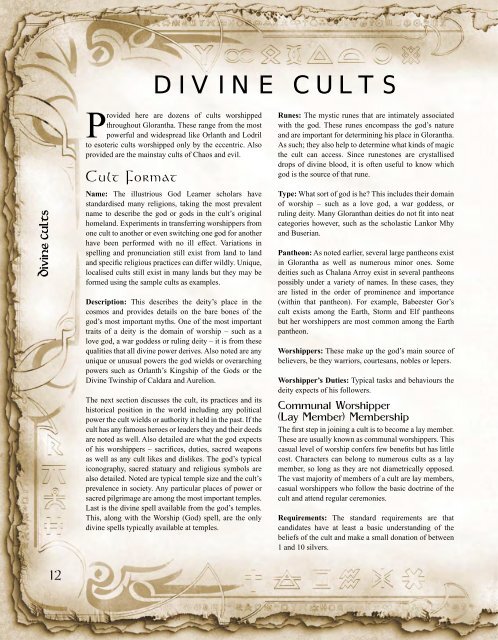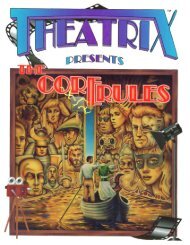Cults of G.. - Index of - Free
Cults of G.. - Index of - Free
Cults of G.. - Index of - Free
You also want an ePaper? Increase the reach of your titles
YUMPU automatically turns print PDFs into web optimized ePapers that Google loves.
Divine <strong>Cults</strong><br />
12<br />
DIVINE CULTS<br />
Provided here are dozens <strong>of</strong> cults worshipped<br />
throughout Glorantha. These range from the most<br />
powerful and widespread like Orlanth and Lodril<br />
to esoteric cults worshipped only by the eccentric. Also<br />
provided are the mainstay cults <strong>of</strong> Chaos and evil.<br />
Cult Format<br />
Name: The illustrious God Learner scholars have<br />
standardised many religions, taking the most prevalent<br />
name to describe the god or gods in the cult’s original<br />
homeland. Experiments in transferring worshippers from<br />
one cult to another or even switching one god for another<br />
have been performed with no ill effect. Variations in<br />
spelling and pronunciation still exist from land to land<br />
and specific religious practices can differ wildly. Unique,<br />
localised cults still exist in many lands but they may be<br />
formed using the sample cults as examples.<br />
Description: This describes the deity’s place in the<br />
cosmos and provides details on the bare bones <strong>of</strong> the<br />
god’s most important myths. One <strong>of</strong> the most important<br />
traits <strong>of</strong> a deity is the domain <strong>of</strong> worship – such as a<br />
love god, a war goddess or ruling deity – it is from these<br />
qualities that all divine power derives. Also noted are any<br />
unique or unusual powers the god wields or overarching<br />
powers such as Orlanth’s Kingship <strong>of</strong> the Gods or the<br />
Divine Twinship <strong>of</strong> Caldara and Aurelion.<br />
The next section discusses the cult, its practices and its<br />
historical position in the world including any political<br />
power the cult wields or authority it held in the past. If the<br />
cult has any famous heroes or leaders they and their deeds<br />
are noted as well. Also detailed are what the god expects<br />
<strong>of</strong> his worshippers – sacrifices, duties, sacred weapons<br />
as well as any cult likes and dislikes. The god’s typical<br />
iconography, sacred statuary and religious symbols are<br />
also detailed. Noted are typical temple size and the cult’s<br />
prevalence in society. Any particular places <strong>of</strong> power or<br />
sacred pilgrimage are among the most important temples.<br />
Last is the divine spell available from the god’s temples.<br />
This, along with the Worship (God) spell, are the only<br />
divine spells typically available at temples.<br />
Runes: The mystic runes that are intimately associated<br />
with the god. These runes encompass the god’s nature<br />
and are important for determining his place in Glorantha.<br />
As such; they also help to determine what kinds <strong>of</strong> magic<br />
the cult can access. Since runestones are crystallised<br />
drops <strong>of</strong> divine blood, it is <strong>of</strong>ten useful to know which<br />
god is the source <strong>of</strong> that rune.<br />
Type: What sort <strong>of</strong> god is he? This includes their domain<br />
<strong>of</strong> worship – such as a love god, a war goddess, or<br />
ruling deity. Many Gloranthan deities do not fit into neat<br />
categories however, such as the scholastic Lankor Mhy<br />
and Buserian.<br />
Pantheon: As noted earlier, several large pantheons exist<br />
in Glorantha as well as numerous minor ones. Some<br />
deities such as Chalana Arroy exist in several pantheons<br />
possibly under a variety <strong>of</strong> names. In these cases, they<br />
are listed in the order <strong>of</strong> prominence and importance<br />
(within that pantheon). For example, Babeester Gor’s<br />
cult exists among the Earth, Storm and Elf pantheons<br />
but her worshippers are most common among the Earth<br />
pantheon.<br />
Worshippers: These make up the god’s main source <strong>of</strong><br />
believers, be they warriors, courtesans, nobles or lepers.<br />
Worshipper’s Duties: Typical tasks and behaviours the<br />
deity expects <strong>of</strong> his followers.<br />
Communal Worshipper<br />
(Lay Member) Membership<br />
The first step in joining a cult is to become a lay member.<br />
These are usually known as communal worshippers. This<br />
casual level <strong>of</strong> worship confers few benefits but has little<br />
cost. Characters can belong to numerous cults as a lay<br />
member, so long as they are not diametrically opposed.<br />
The vast majority <strong>of</strong> members <strong>of</strong> a cult are lay members,<br />
casual worshippers who follow the basic doctrine <strong>of</strong> the<br />
cult and attend regular ceremonies.<br />
Requirements: The standard requirements are that<br />
candidates have at least a basic understanding <strong>of</strong> the<br />
beliefs <strong>of</strong> the cult and make a small donation <strong>of</strong> between<br />
1 and 10 silvers.



